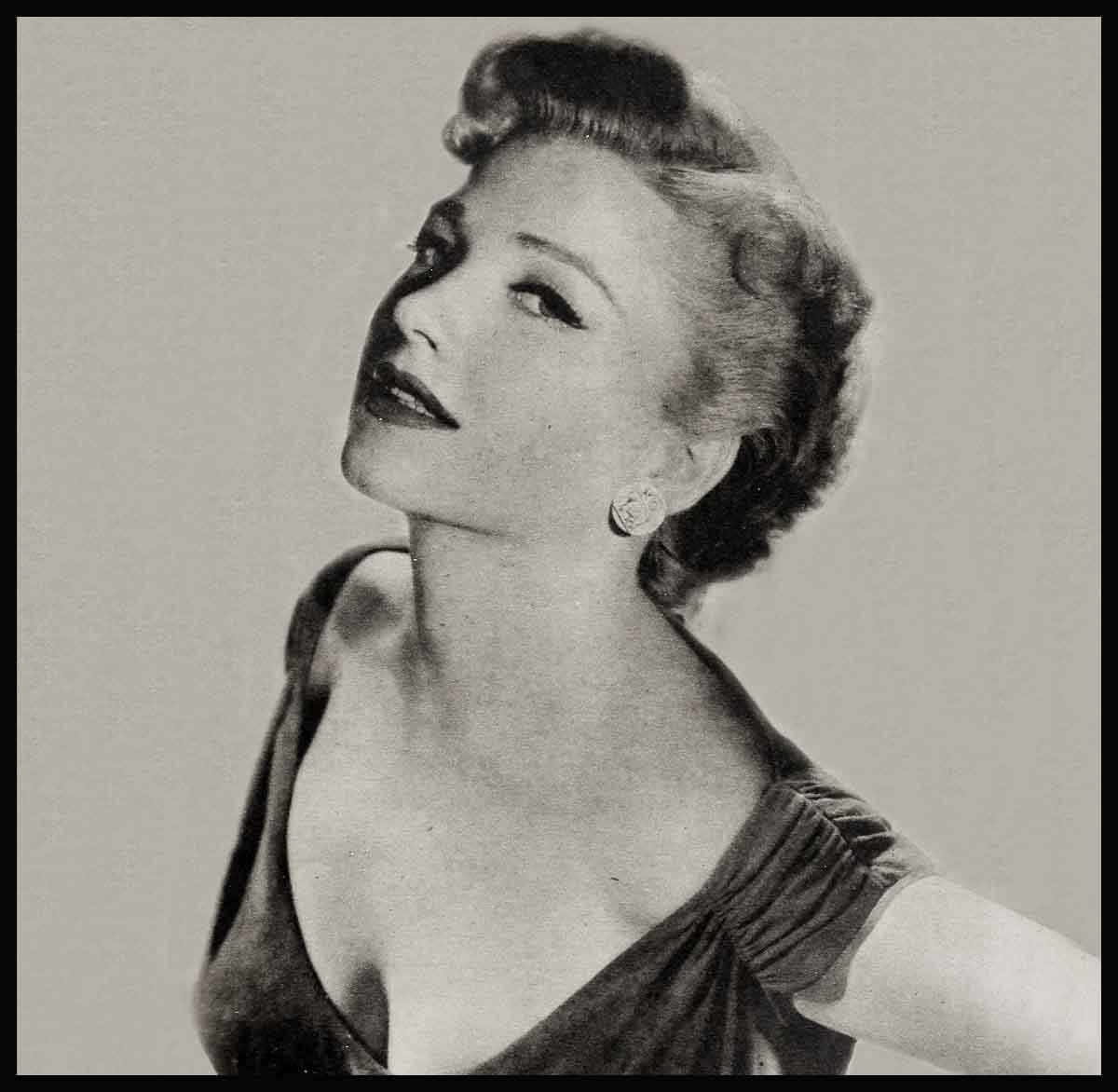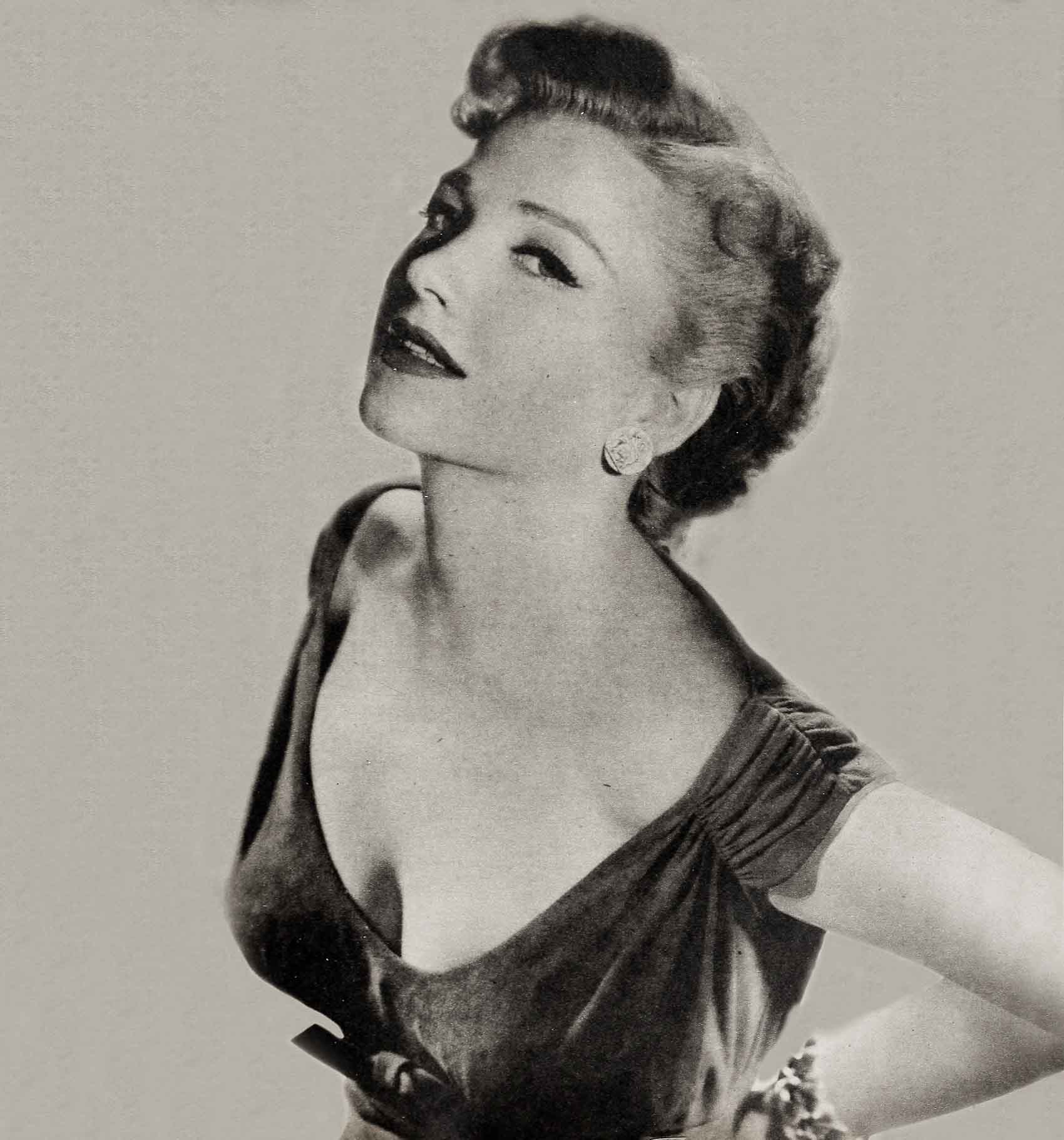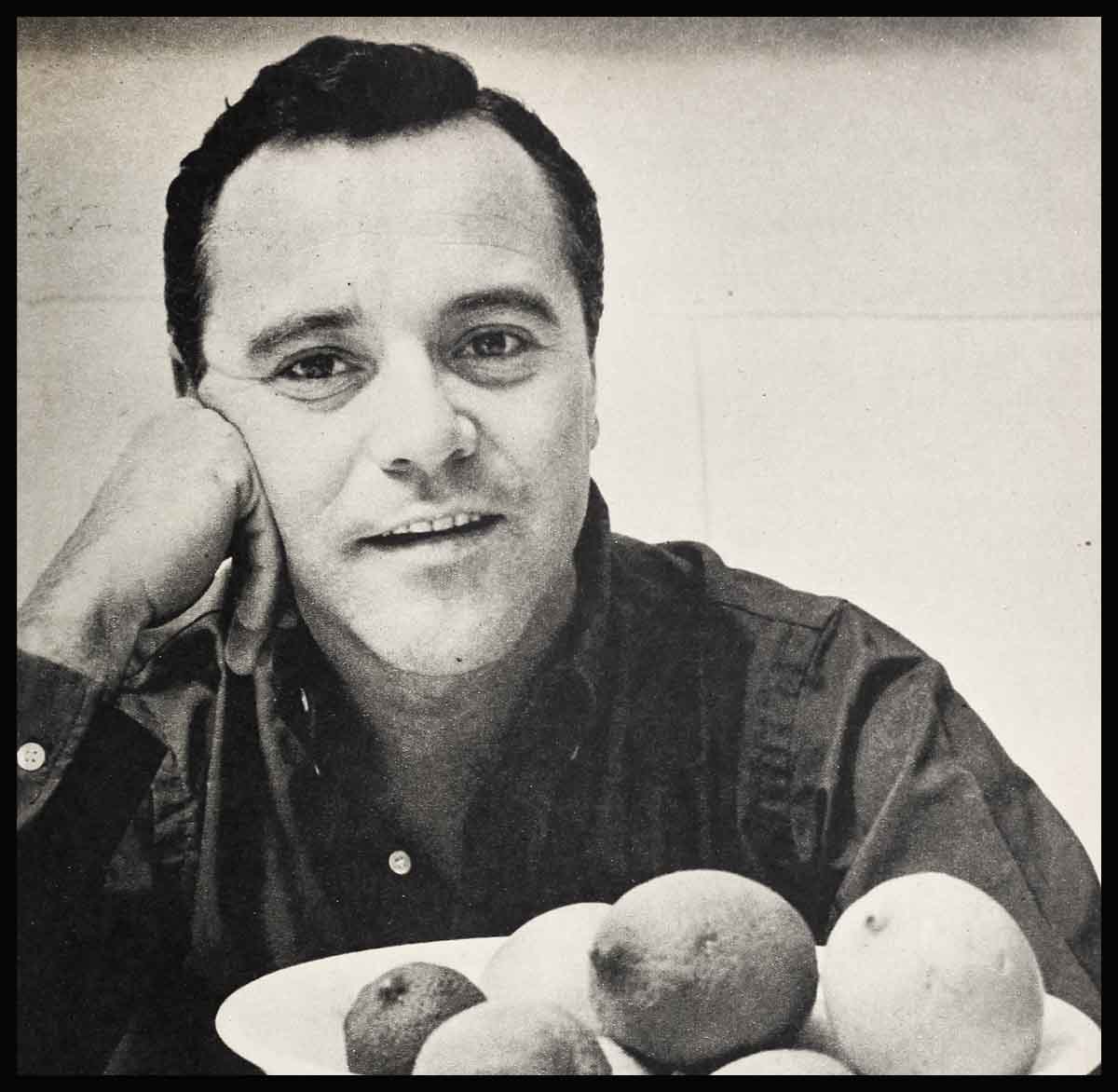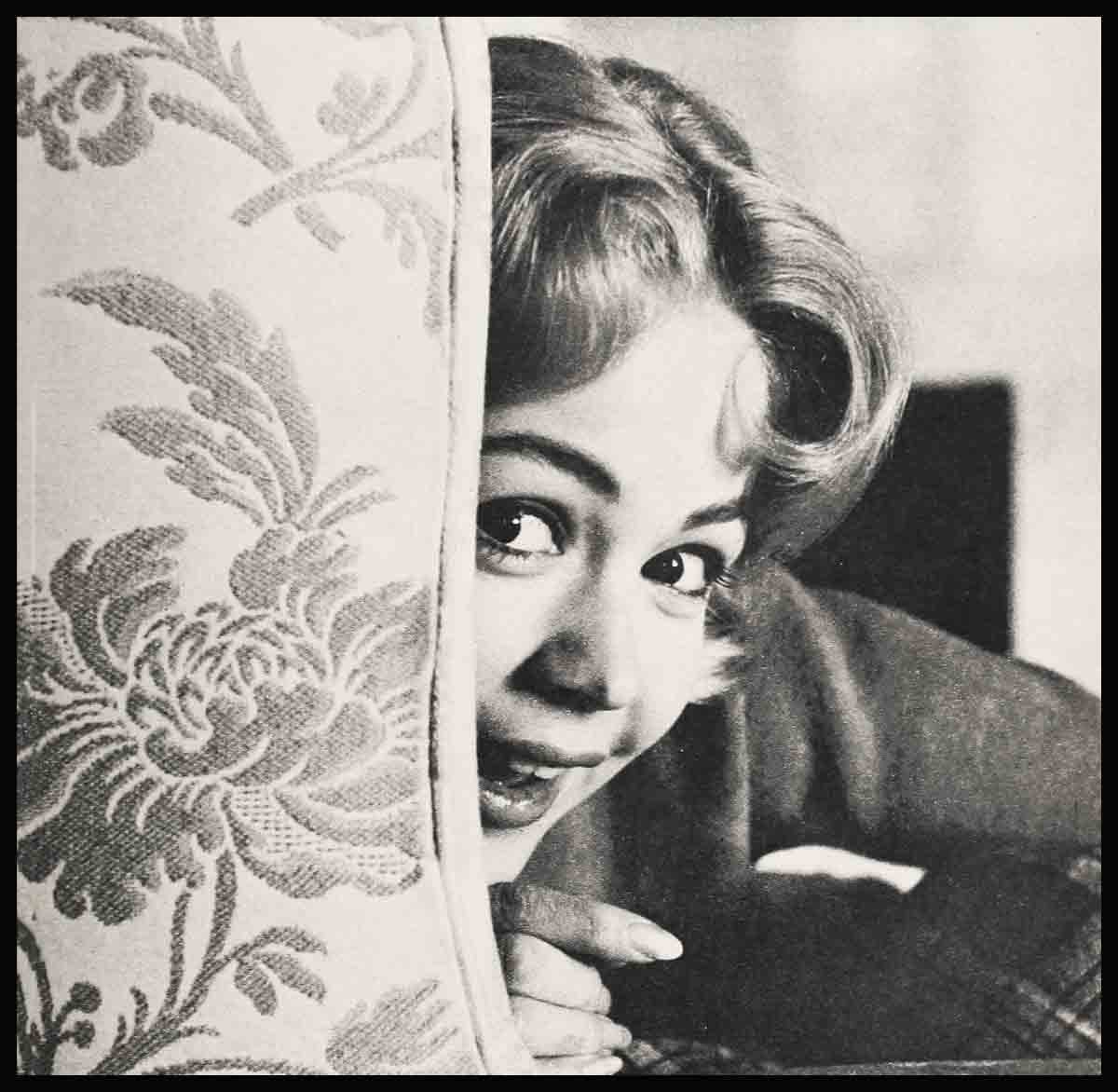
Every Girl Needs Sex Appeal—Anne Baxter
Just before she took off for Quebec where she is currently co-starring with Montgomery Clift in I Confess, Anne Baxter was sitting in the commissary at 20th Century-Fox, munching a ham and swiss on toast.
A director who’s put Anne through the paces in four films, happened to walk into the eatery with Marilyn Monroe.
“Who’s that platinum blonde with the poodle cute” he asked, nodding at Anne.
“Are you kidding?” Marilyn asked.
“No,” said the director. “Who is she? Her face teases my memory.”
“It should,” Marilyn said. “That’s Anne Baxter.”
The director did a double take. “Anne Baxter?” He walked over to the table and sat down. “Holy catfish!” he exploded. “It really is you, Anne, isn’t it?”
Anne Baxter, one of Hollywood’s finest dramatic actresses, the brainy, demure, talented brunette who won an Oscar for her marvelous portrayal of a lost woman in Razor’s Edge and an Academy Award nomination for her outstanding work in All About Eve has gone on a sex appeal kick.
She has cut her hair short.
She has had it dyed blonde.
She has reduced her weight to 107 lbs.
She has reduced the necklines on her dresses to new and daring lows.
She has posed for cheesecake pictures in bathing suits that leave precious little to the imagination.
She has experimented with wearing artificial beauty marks and eyelashes.
In short, Anne is fed up with the way she’s been presented to the public and is determined to become more sexy, more stimulating, more exciting—three adjectives, she feels, every girl should have.
“I’ve been presented,” Anne sadly admits, “as a terribly nice. person, a good actress, a kind wife, a thoughtful mother. If I were running for office, if I wanted to become the mayor of Beverly Hills, that description would be wonderful. But let’s face it. I’m an actress. I’m supposed to sound stimulating, look exciting.
“In the past my sex appeal has been kept in shackles. My fan mail, for example, has always consisted of letters congratulating me on my acting ability, my interpretation of various roles. I appreciate those letters. I really do. But why haven’t I gotten any mail asking for pinup photos? The answer is simple: men, because of my films and reputation, have regarded me as brainy, dull, motherly, practical, anything but sexy.
“In all honesty I must admit that I’m no holier-than-thou. I’m not Gree-ah Garson. I’m a young actress who resents being presented as dull and inhibited.”
In addition to re-doing herself physically, Anne, a few weeks ago, joined the growing line of top-flight screen stars—Tyrone Power, Cary Grant, Betty Hutton, Alan Ladd, Kathryn Grayson—who prefer freelancing to studio contracts.
After 11 years at 20th Century-Fox, Anne walked into Darryl Zanuck’s office one morning and asked for her release.
Her contract, at $3500 a week, ran until the spring of 1953.
When I asked Anne why she was giving up the security of a contract long before it expired, she said, “With me it’s just a matter of professional growing pains. I’ve been under contract all my working life, and now I want to do some experimenting on my own. I am indebted to the studio for all the great breaks and guidance it gave me. But there are some exciting things going on in the show world and I want in on them. For example, Paul Gregory, theatrically speaking, has found a new world in America and we have been talking. I want to be free to hit the road for him in some vibrant, exciting work such as his stage productions of Don Juan In Hell and John Brown’s Body. I also want to be free to travel, to make a picture in Europe or South Africa and naturally here in Hollywood. I think the world is too exciting right now to stay put in any one place.”
Anne’s great handicap, at least she currently regards it as a handicap, is that she talks like the literate, sensitive, perceptive, aggressive, knowing actress she is.
Her personality seems to accentuate her intelligence rather than the body beautiful. A friend who knows her well explains her desire to appear sexy in these words. “It took Anne 11 years to achieve fame and stardom in Hollywood. All of a sudden a girl named Marilyn Monroe comes along. Let’s face it. All Monroe has is sex. It oozes out of her the way toothpaste oozes out of a tube.

“Monroe’s been at the studio only a few years. She’s played mostly bits. But today she gets more fan mail, more publicity than any other actress in town. You don’t have to be an intellectual giant to realize that sex pays off. Baxter has come to that conclusion. Having a brain is very important but nobody buys tickets at the box office to see it. Maybe it sounds crass, but the average male movie-goer today is more interested in the bust than in the brain. Anne realizes that love is what makes the world go ’round.”
In fact, Anne Baxter says very frankly that it’s time to bring back longer-lasting, and more passionate kisses to the screen.
“The motion picture industry was partly built on great, uninhibited love scenes,” she told me. “Today stars give each other gentle pecks and let it go at that, or the camera cuts away from them just as they really get into the spirit of the thing. The emotional excitement that meant so much to people back in the silent days of pictures is gone.
“Why do you think a picture like A Place In The Sun brought so many women storming to the movie houses? Word got around that the clinches between Montgomery Clift and Elizabeth Taylor were realistic. And the closeups too.”
Baxter also has a theory about why so many females attend the French and Italian movies, and it has nothing to do with learning a foreign language.
According to Anne, “Foreign stars kiss as if they enjoy it. They go in for historical kissing, too. We haven’t had that in Hollywood since Garbo and Gilbert.”
In Hollywood, Anne points out, a man with a stopwatch stands on the sidelines when an actor and actress go into a clinch. If the kiss lasts more than twenty or thirty seconds, the scene is re-taken, and the’ players are told to speed it up.
“While making My Wife’s Best Friend with MacDonald Carey,” Anne says, “we held a kiss a couple of seconds too long. We had to shoot the scene over again. It doesn’t make sense, doing things like that. That scene, as Mac and I felt it—well, it could drag a lot of people who have lost the movie habit back to theatres. There are so many unloved people in the world who need a little warmth from movies. Why short-change them?”
To people who don’t know Anne or who merely know her by her staid, country-club type of reputation, the preceding quotations may seem out of character, but the simple truth is that ever since she fell in love with John Hodiak, Anne has been an out-spoken, down-to-earth, lusty female.
The studio has played her up as the grand-daughter of Frank Lloyd Wright, the great founder and practitioner of modern architecture, either forgetting or not knowing that when Wright was a young man, he was involved in some of the most tempestuous love affairs of the century. If Anne’s. love life, as a matter of fact, were to follow in the footsteps of her illustrious grandfather’s, she herself would be involved in some of the choicest scandals of all time, because Wright always was and still is, despite his advanced age, a rugged individualist who will brook no interference with his plans and ideas. He had several wives, was in trouble with many of them, and for many years his marital difficulties made intriguing headlines.
Anne herself says. “My grandfather, Frank Lloyd Wright, the architect, wore only a red sash on his wedding night. That’s glamor.”
Anne also attributes her current change in appearance and outlook to her grandfather. “He always says,” she explains, “that a habit of any kind is absolute death. ‘Never let a habit become a habit’ is a favorite maxim of his.”
When she was 11 years old, young hazel-eyed Anne Baxter was sure she had been born to be a wall-flower. “I hated that,” she recalls, “but I must have been a precocious brat because I did something about it. I decided that wall-flowers were people other people didn’t look at, and I wanted to be looked at—in a nice way. So I thought that if I were on the stage, people would have to look at me.”
Anne’s parents sympathized with hex ambition and enrolled her in the Theodore Irving School of Dramatics. When she was all of 12 she made her stage debut. A few years later she was playing in summer stock at Dennis, Mass. Anne also starred on Broadway with Gladys Cooper and Eva Le Gallienne, two veteran performers, who taught her plenty. Several years of study with Maria Ouspenskaya, and Anne was called to Hollywood to test for the lead in Rebecca. She made eight tests for the part, then David Selznick decided to postpone production. Back to New York went Anne, puzzled and disappointed, but not for long. Darryl Zanuck asked her to test for Stage Door, and when he saw the result, signed her immediately.
Anne came to Hollywood with her mother. She was 16 at the time, and mother watched her like a hawk. Anne’s first picture was with John Barrymore in The Great Profile. Her second was with Jack Benny in Charley’s Aunt.
She was rather plump, very serious, very talented but not too sexy. She had dates and boy friends but no one very serious until John Hodiak walked into her life. Hodiak was a former radio announcer from Chicago, the son of immigrant parents, and he’d come up the hard way.
It was whispered around town when Anne and John started going together that Mrs. Baxter didn’t think this was a suitable combination. But Hodiak wasn’t particularly interested in rumors, founded or unfounded, concerning his future mother-in-law’s opinion of him.
It made no difference to John that Mrs. Baxter was Frank Lloyd Wright’s daughter. This was pure accident. Mrs. Baxter had nothing whatever to do with choosing her parents. Hodiak wasn’t impressed either with the fact that Anne’s father, Kenneth Baxter, was sales manager for the Frankfort Distilleries. He was in love with Anne and he would have proposed if her father had played third base for the San Quentin Eagles and her mother had been graduated from a school for delinquents. This boy was really taken with everything about Anne, her poise, her erudition, her savoir-faire and her sex appeal.
When Mrs. Baxter realized that marriage was inevitable, she graciously gave her consent and the ceremony was held at the Baxter home in Burlingame, California. That was in 1946. Last year the Hodiaks had their first child, a daughter, Katrina.
Hodiak may not be as talented as Anne’s grandfather, but he certainly is an infinitely better husband. Thus far, for example, he’s said nothing about Anne’s platinum blonde hair, the poodle cut, the false eyelashes, her new insistence upon glamour and sex appeal. To him, Anne has always been loaded with these attributes.
As regards the public, Anne now feels she must be a little more obvious with what physical charms nature has endowed her. “Every girl,” she says, “needs sex appeal.”
Apparently that, even holds when a girl is a successful actress, is earning $3,500 a week, has captured a handsome husband, earned a magnificent career and given birth to an utterly delightful baby.
THE END
—BY CONSUELO ANDERSON
It is a quote. MODERN SCREEN MAGAZINE NOVEMBER 1952





No Comments